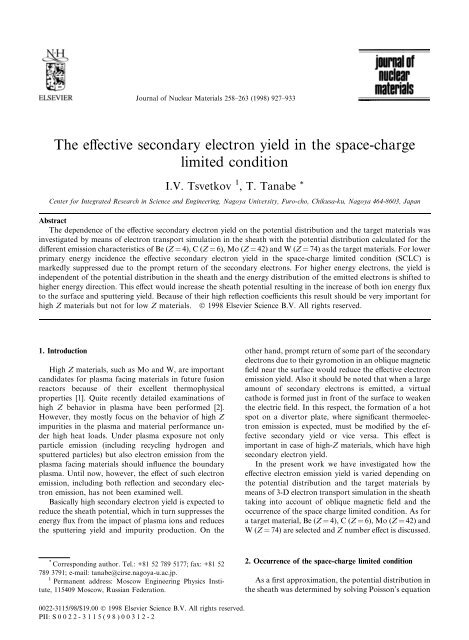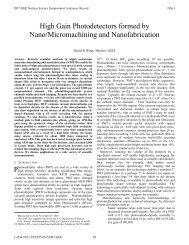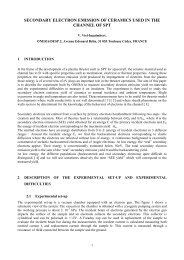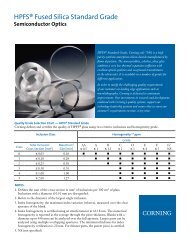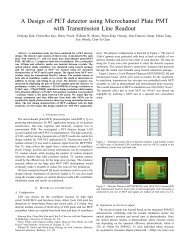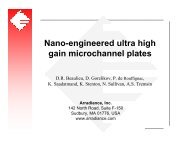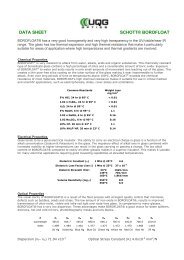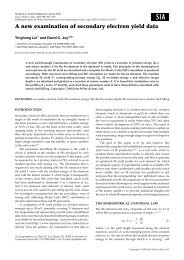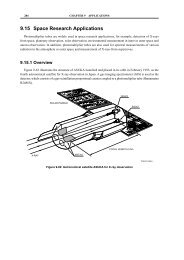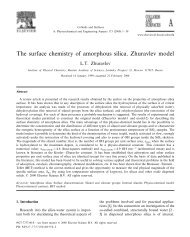The effective secondary electron yield in the space-charge limited ...
The effective secondary electron yield in the space-charge limited ...
The effective secondary electron yield in the space-charge limited ...
You also want an ePaper? Increase the reach of your titles
YUMPU automatically turns print PDFs into web optimized ePapers that Google loves.
I.V. Tsvetkov, T. Tanabe / Journal of Nuclear Materials 258±263 (1998) 927±933 931Fig. 4. E€ective <strong>electron</strong> <strong>yield</strong> d e for W, Mo, C and Be aga<strong>in</strong>st E p . T e ˆ 30 eV, n 0 ˆ 10 18 m 3 .of plasma density (Figs. 4 and 6). That is because <strong>the</strong>gyro-radius of high-energy <strong>electron</strong>s is close to <strong>the</strong>sheath thickness and <strong>electron</strong>s easily escape from anoblique magnetic ®eld. Even if <strong>the</strong> magnetic ®eld wasparallel to <strong>the</strong> surface, d e would not be zero ow<strong>in</strong>g tohigher re¯ection.Below a primary <strong>electron</strong> energy E p ˆ 4 keV <strong>the</strong><strong>secondary</strong> <strong>electron</strong> <strong>yield</strong> is nearly <strong>the</strong> same for a sheaththickness d ˆ 10k D as for d ˆ 5k D , as shown <strong>in</strong> Fig. 7.Above 4 keV, d e is smaller for d ˆ 10k D . For d ˆ 5k D<strong>the</strong> <strong>secondary</strong> <strong>electron</strong> <strong>yield</strong> <strong>in</strong>creases above 4 keV andfor d ˆ 10k D above 16 keV, because <strong>the</strong> energy has to beFig. 5. Contribution of <strong>the</strong> re¯ected <strong>electron</strong>s on <strong>the</strong> e€ective <strong>electron</strong> <strong>yield</strong> as a function of E p . T e ˆ 30 eV, n 0 ˆ 10 18 m 3 .
932 I.V. Tsvetkov, T. Tanabe / Journal of Nuclear Materials 258±263 (1998) 927±933Fig. 6. E€ective <strong>electron</strong> <strong>yield</strong> d e for W, Mo, C and Be aga<strong>in</strong>st E p . T e ˆ 30 eV, n 0 ˆ 10 19 m 3 .raised four times to <strong>in</strong>crease gyration radius twice from5k D to 10k D .Hence for low primary <strong>electron</strong> energy (below 4 keV)d e is <strong>in</strong>dependent of <strong>the</strong> sheath thickness, whereas forhigh primary <strong>electron</strong> energy d e is <strong>in</strong>dependent of <strong>the</strong>potential distribution <strong>in</strong> <strong>the</strong> sheath.It should be mentioned that <strong>the</strong> electric ®eld just <strong>in</strong>front of <strong>the</strong> surface dom<strong>in</strong>ates <strong>the</strong> e€ective <strong>secondary</strong><strong>electron</strong> <strong>yield</strong> <strong>in</strong> <strong>the</strong> present simulation. This was con-®rmed by an additional calculation us<strong>in</strong>g <strong>the</strong> electric®eld E…x† ˆ E 0 …x=d† 1=3 for <strong>the</strong> Child±Langmuir <strong>space</strong>limitation [9] which has similar electric ®eld to presentSCLC regime for x < k D :Fig. 7. E€ective <strong>electron</strong> <strong>yield</strong> d e for W aga<strong>in</strong>st E p for <strong>the</strong> sheath thickness d ˆ 5k D and d ˆ 10k D . T e ˆ 30 eV, n 0 ˆ 10 18 m 3 .
I.V. Tsvetkov, T. Tanabe / Journal of Nuclear Materials 258±263 (1998) 927±933 9336. ConclusionsFor lower primary energy <strong>in</strong>cidence, <strong>the</strong> e€ective<strong>secondary</strong> <strong>electron</strong> <strong>yield</strong> is substantially suppressed <strong>in</strong><strong>the</strong> SCLC regime because of <strong>the</strong> signi®cant reduction of<strong>the</strong> low energy <strong>secondary</strong> <strong>electron</strong>s (below 4 keV) ow<strong>in</strong>gto <strong>the</strong>ir direct return to <strong>the</strong> surface by <strong>the</strong> gyration.Accord<strong>in</strong>gly <strong>the</strong> energy distribution of <strong>the</strong> emitted<strong>electron</strong>s is shifted to higher energy direction.For higher primary energy <strong>in</strong>cidence, <strong>the</strong> <strong>yield</strong> isdom<strong>in</strong>ated by <strong>the</strong> re¯ected <strong>electron</strong>s which have ra<strong>the</strong>rhigh energy and are less <strong>in</strong>¯uenced on <strong>the</strong> obliquemagnetic ®eld. <strong>The</strong>refore <strong>the</strong> <strong>yield</strong> becomes <strong>in</strong>dependentof <strong>the</strong> potential distribution <strong>in</strong> <strong>the</strong> sheath. In o<strong>the</strong>rwords, <strong>the</strong> population of higher energy <strong>electron</strong> is notreduced and <strong>the</strong> number of <strong>electron</strong>s com<strong>in</strong>g back to <strong>the</strong>plasma with energy above 4 keV would be enhanced.Such enhancement of high energy <strong>electron</strong> emissionwould <strong>in</strong>crease <strong>the</strong> sheath potential result<strong>in</strong>g <strong>in</strong> <strong>the</strong> <strong>in</strong>creaseof both energy ¯ux to <strong>the</strong> surface and sputter<strong>in</strong>g<strong>yield</strong>. This e€ect seems very important for high-Z materialsbecause of <strong>the</strong>ir high re¯ection coecients.S<strong>in</strong>ce <strong>the</strong> re¯ection coecient of low-Z materials isgenerally small, <strong>the</strong> e€ect of <strong>the</strong> emitted <strong>electron</strong> doesnot seem important. However, because <strong>the</strong> <strong>secondary</strong><strong>electron</strong> <strong>yield</strong> for Be and C <strong>in</strong>creases above 4 keV, <strong>the</strong>enhancement of high energy <strong>electron</strong> emission could beobserved for higher energy <strong>in</strong>cidence. Never<strong>the</strong>less <strong>the</strong>absolute value d e for low-Z materials is much smallerthan 1 and <strong>the</strong> appearance of <strong>the</strong> SCLC regime is unlikely.In conclusion <strong>the</strong> e€ect of <strong>the</strong> <strong>secondary</strong> <strong>electron</strong>emission on <strong>the</strong> boundary plasma should be very importantfor high-Z materials but not for low-Z materials.In <strong>the</strong> present work we did not consider <strong>the</strong> <strong>in</strong>¯uenceof <strong>the</strong> high energy <strong>electron</strong> emission on <strong>the</strong> potentialdistribution <strong>in</strong> <strong>the</strong> sheath for simplicity. To developmore realistic self-consistent model it must be taken <strong>in</strong>toaccount.References[1] T. Tanabe, Suppl. J. Nucl. Fusion 5 (1994) 129.[2] N. Noda, V. Philipps, R. Neu, J. Nucl. Mater. 241±243(1997) 227.[3] G.D. Hobbs, J.A. Wesson, Plasma Phys. 9 (1967) 85.[4] R. Kollath, <strong>in</strong>: S. Flugge (Ed.), Handbuch der Physik, vol.21, Spr<strong>in</strong>ger, Berl<strong>in</strong>, 1956, p. 232.[5] J. Kawata, K. Nishimura, A. Harada, K. Ohya, Radiat.E€e. Def. Solids 142 (1996) 607.[6] E.W. Thomas, Atomic and Plasma±materials InteractionData for Fusion, vol. 1, 1991, p. 79.[7] E.J. Sternglass, Phys. Rev. 95 (1954) 345.[8] I.M. Bronshte<strong>in</strong>, R.B. Segal, Sov. Phys. ± Solid State 1(1959) 1142.[9] I. Langmuir, Phys. Rev. 33 (1929) 954.


